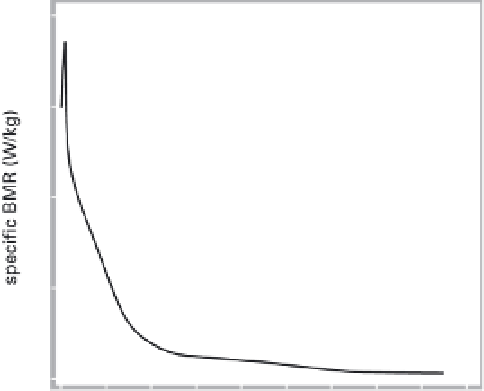Environmental Engineering Reference
In-Depth Information
requirements during a 24-h period. The physical activity
level (PAL) for a 24-h period is a quotient of TEE/BMR
(TEE is the product of BMR and PAL). PAL expresses
the energy cost of a specific activity as a multiple of
BMR, and the metabolic equivalent (MET), the quo-
tient of work rate and RMR, is roughly equal to the
cost of sitting.
Determination of energy costs of activities used to be a
much greater challenge than measuring BMR. Rigging
up and wearing the apparatus necessary for accurate
respirometry (masks, hoods or mouthpieces, and hoses
needed to measure gas exchange) is no problem when
testing a cyclist on a stationary bicycle, but it is a chal-
lenge for measuring the costs of coal mining or mountain
climbing. Three portable systems that can be used for
continuous measurements of oxygen uptake for long
periods are in widespread use (Patton 1997), and many
values have been gathered by decades of dedicated re-
search (Durnin and Passmore 1967; FAO 2003). Two
convenient methods now allow nonintrusive measure-
ment of actual energy expenditures: the doubly labeled
water technique (see section 4.1) and heart rate monitor-
ing (HRM). The DLW technique allows the calculation
of total energy use over the course of several days; it has
been accepted as the best way of measuring the TEE of
free-living individuals. Heart rate monitoring measures
daily energy expenditure by relating minute-by-minute
pulse to the rate of oxygen consumption using calibra-
tions previously determined by laboratory respirometry.
The energy needed for growth is about 40% of TEE
during the first month, averages 35% for the first three
months, is halved to 17.5% during the subsequent three
months, and drops to 3% by the end of the first year and
<
2% a year later. The rate remains between 1% and 2%
until middle adolescence and is absent by the age of 20.
5.3
Decline of BMR with age. Plotted from data in FAO
(2004).
5.2 Requirements and Uncertainties
Human energy requirements are defined as intakes that,
in adults, maintain body weight and composition, and
support a desirable level of physical activity and long-
term health. In children they also have to cover the req-
uisite growth needs, in pregnant women the deposition
of new tissues, and in lactating women the production
of milk. BMR usually dominates, and activity needs—
energy spent at work and in leisure and varying with the
nature, intensity, and duration of the tasks—account for
most of the remainder. The requirements of growth (the
sum of the energy values of the newly formed tissues and
products, and the cost of their synthesis) claim a signifi-
cant share in infants and children but are absent after
adolescence. There are two other kinds of gender-specific
requirements, the energy needs of pregnant and lactating
women. The TEE of an individual is the sum of all these











